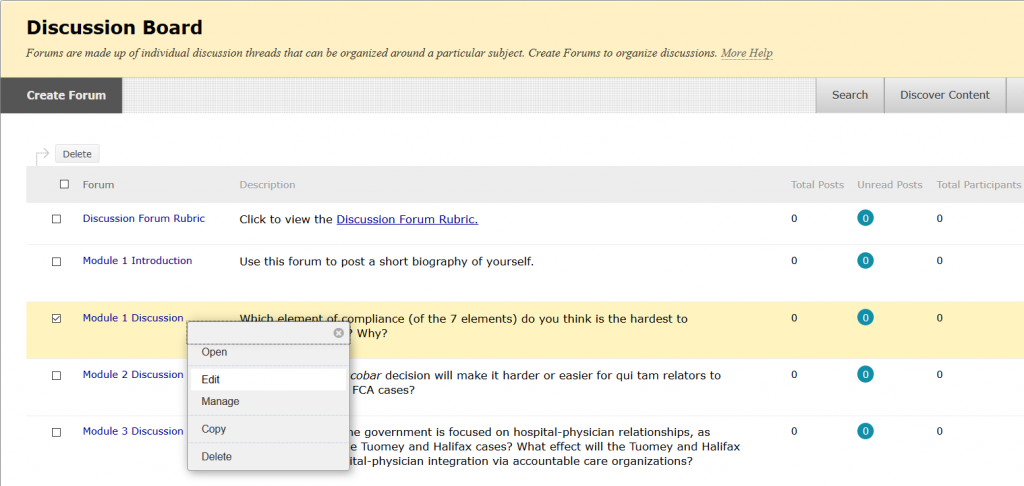Description
Online discussions are most effective when students engage in higher order thinking, taking time to reflect and compose original posts. Instructors play a key role in purposefully designing discussion forums that move “student discourse out of the margins of thinking to deeper levels of thought” (Williams, Jaramillo, Peski, 2015, p. 46). The post-first discourse strategy is one way that online instructors of any discipline can easily encourage deep and divergent thinking, and avoid learners’ parroting of responses (Kim, Wah, & Lee, 2007). Post-first simply entails modifying the Forum Settings within the University Learning Management System (LMS) to change students’ viewing permissions of threads and replies.
Link to example artifact(s)
Within a Health Care Compliance Certificate Program, post-first was implemented in a series of eight courses hosted in Blackboard, in which students were required to “create a thread in order to view other threads in the forum”. After one semester, post-first quickly gained popularity among program instructors and became the default method for eliciting discussion. Instructors reported improvements in the quality and length of students’ posts (approximately 800 words), while course evaluations indicated that most students (93%) felt they contributed to the classroom learning through their discussion postings. Summarizing the value of post-first, one student commented, “I liked that the [discussion] board was not open to viewing until your initial post. This helped to build my thinking as an individual.”
Figures 1 and 2 depict how to navigate to the Forum Settings menu in the Blackboard LMS and select the Viewing Threads/Replies option that requires participants to create a new thread in order to view other threads in the forum.


Students are made aware of the post-first setting before creating a thread, through the message displayed in Figure 3.

Link to scholarly reference(s)
Kim, T. L. S., Wah, W. K., &, Lee, T. A. (2007). Asynchronous electronic discussion group: Analysis of posting and perception of in-service teachers. Turkish Online Journal of Distance Education, 8(1), 33-42.
Williams, S. S., Jaramillo, A., & Pesko, J. C. (2015). Improving depth of thinking in online discussion boards. Quarterly Review of Distance Education, 16(3), 45-66.
Citation
Mancilla, R., Cochenour, L., & Crossley, M. (2017). Post first discourse. In B. Chen, A. deNoyelles, & A. Albrecht (Eds.), Teaching Online Pedagogical Repository. Orlando, FL: University of Central Florida Center for Distributed Learning. https://topr.online.ucf.edu/post-first-discourse/.